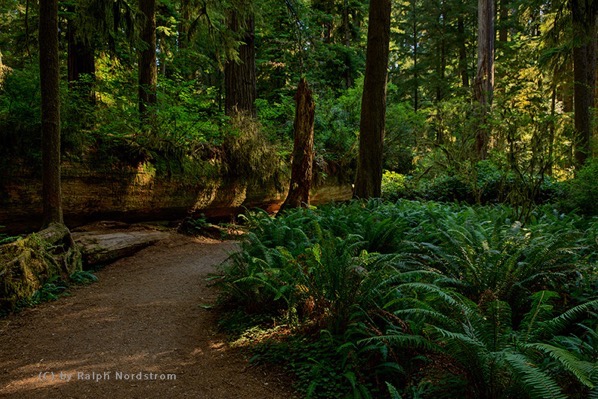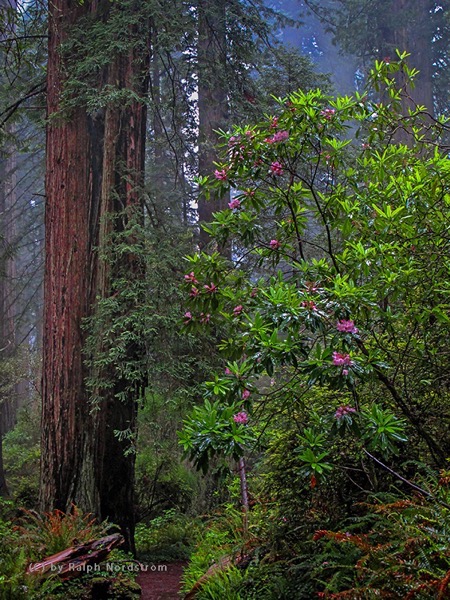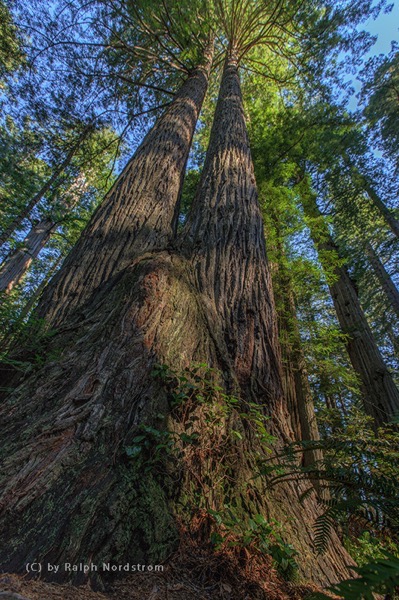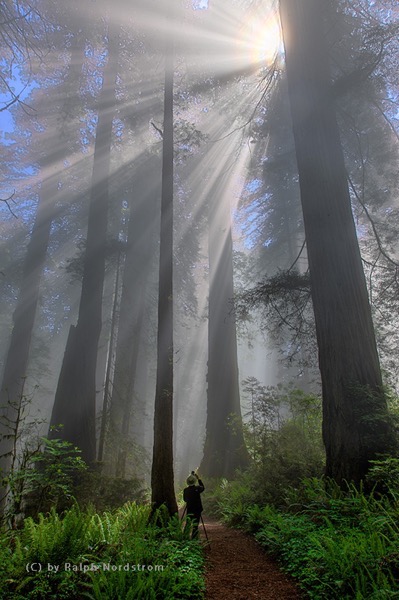It’s 6:00 in the morning. I’m in my car, leaving our Southern California neighborhood and making my way to the freeway. I’m heading north and have to cross the LA basin which, at this time of day, is not easy. But I have a destination that is calling me. I’m on my way to the redwoods of Northern California, 800 miles from home. I’m looking forward to feeling small and insignificant and renewed among these magnificent trees.
There are two types of redwood trees in North America and practically all of them are in California. The coastal redwoods, where I’m headed, are the tallest living organisms on the planet with the tallest topping out at 379 feet. They are found in groves that span over 450 miles from Big Sur in the south to just across the Oregon border in the north. They thrive on the fogs that are common along the coast.
The other redwood tree is the Giant Sequoia that grows on the western slopes of the Sierra Nevada mountains. Where the coastal redwoods are tall and slender, the giant sequoia are of enormous girth. They are considered to be the most massive living organism on the planet. (But a rumor is spreading that a coastal redwood was found recently that is more massive than the largest giant sequoia, and thereby giving the coastal redwoods both titles.)
I made it out of the LA basin, crossed over the Grapevine on I-5 and into the great central valley of California. This stretch of I-5 is considered by many to be the most boring highway in the country with mile after mile of pretty much the same, barren landscape. After what seems like endless hours I turn west towards the Bay Area. This will be anything but uneventful.
Making it through the East Bay is more than 100 miles of congestion and is not something I look forward to. In fact, it’s fair to say that I dread it. I enjoy the Richmond Bridge; I think I like it more than Golden Gate. But getting there usually requires navigating mile upon mile of stop and go traffic and once it is crossed, there’s more of the same on the other side. Arg.
But when it’s finally behind me the promise of the serene redwoods comes over me and I’m excited again, re-energized and eager to continue.

Healdsburg on the Russian River, besides having one of my favorite bakeries, is where highway 101 really starts to get interesting. But first, I have to make a quick stop at the Cousteau Bakery. Suitably provisioned, I’m ready to head north and from this point on, every mile is better than the last. The highway follows the Russian River for a while through foothills that host gnarly coastal live oaks.
Leaving the Russian River behind each scene that passes by is more wondrous – the Eel River gorge, mountain tapestries of thick conifers, the legendary Avenue of the Giants, Humboldt Redwoods State Park, Eureka with its old town recalling the glory of the logging days, Arcata Bay, Orick (with another favorite, the Palm Café with homemade pie – OK, I had to stop for my usual – a bowl of chili and a piece of blue berry pie).

The drive continues with Prairie Creek State Park and the incomparable Newton B. Drury Scenic Drive, the Klamath River, False Klamath Cove, Trees of Mystery, Damnation Creek, Del Norte and finally Crescent City itself. Every mile brings me closer to the peace and inspiration I seek and finally, after a long drive, I have arrived. I’m not tired; how could I be with such an inspirational drive. I check into the hotel, reconnecting with my friends at the front desk, and move into my usual room. It’s good to be back.
Each of the redwood groves has its own unique character. The Lady Bird Johnson grove in Prairie Creek State Park is on a hilltop and has provided some of the best God Rays I have yet encountered. The trails off of the Newton B. Drury Scenic Drive are in a fern and sorrel carpeted valley with many giant trees including one that, during the exuberance of the logging days, lumberjacks thought would be cool to cut down and turn the stump into a dance floor. Damnation Creek sports a plethora of rhododendron bushes and when in bloom it is enchanting. Stout Grove is an old growth forest on the banks of the Smith River that ls like walking through a park. And the Simpson Reed grove, donated and preserved by one of the largest and most responsible of the logging companies, has fallen trees whose exposed roots tower over our heads and hemlock trees growing atop fallen redwoods, their roots extending over the tree and down into the life-giving soil.

There are other groves, ones that are more remote. The Tall Trees grove is at the bottom of a steep trail. Access is limited and the tallest known tree, the Hyperion tree, is somewhere in that area but remains unidentified to protect it from vandalism and from being loved to death. And the mysterious Grove of the Titans that has trees that are incomprehensible and humbling in size.
These priceless groves are places of peace and reflection where these trees, many of which are 2000 years old, instill a feeling of calm and humility. It’s rejuvenating to walk among them.

Photographing these trees and the groves in which they grow is a privilege that is passed on to us through the efforts of organizations and people who value these wonders and have worked long and hard to preserve then. If we can photograph the majesty and mystery, the grand and the intimate, the colossal and the delicate, in sunlight and life-giving fog, we can perhaps capture the essence of these tree for ourselves and share with others.
But in truth, I don’t think it’s the photographs that are the most rewarding, no matter how good. It is being there, allowing oneself to become quiet and feel the presence and peace of these enormous trees.
You can experience these majestic trees for yourself. Join me for the Redwoods Photography Workshop in May.
(104)
